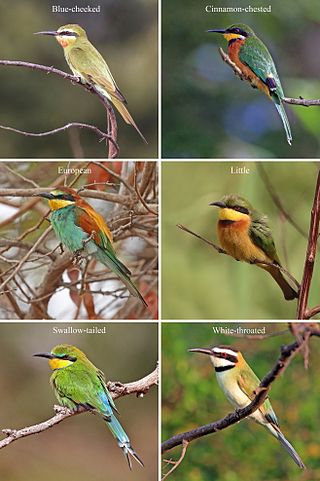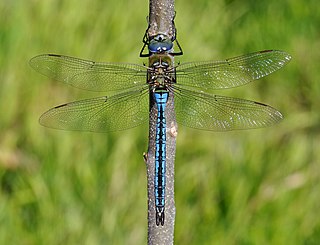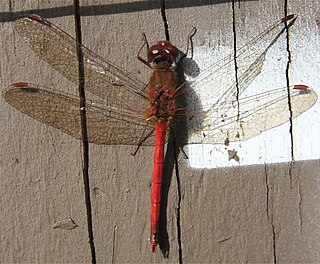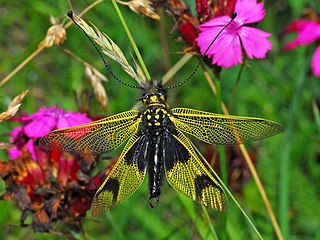
Odonata is an order of flying insects that includes the dragonflies and damselflies.

A dragonfly is a flying insect belonging to the infraorder Anisoptera below the order Odonata. About 3,000 extant species of true dragonflies are known. Most are tropical, with fewer species in temperate regions. Loss of wetland habitat threatens dragonfly populations around the world. Adult dragonflies are characterized by a pair of large, multifaceted, compound eyes, two pairs of strong, transparent wings, sometimes with coloured patches, and an elongated body. Many dragonflies have brilliant iridescent or metallic colours produced by structural coloration, making them conspicuous in flight. An adult dragonfly's compound eyes have nearly 24,000 ommatidia each.
A common classification of the Lepidoptera involves their differentiation into butterflies and moths. Butterflies are a natural monophyletic group, often given the suborder Rhopalocera, which includes Papilionoidea, Hesperiidae (skippers), and Hedylidae. In this taxonomic scheme, moths belong to the suborder Heterocera. Other taxonomic schemes have been proposed, the most common putting the butterflies into the suborder Ditrysia and then the "superfamily" Papilionoidea and ignoring a classification for moths.

The bee-eaters are a group of birds in the family Meropidae, containing three genera and thirty species. Most species are found in Africa and Asia, with a few in southern Europe, Australia, and New Guinea. They are characterised by richly coloured plumage, slender bodies, and usually elongated central tail feathers. All have long down-turned bills and medium to long wings, which may be pointed or round. Male and female plumages are usually similar.

Damselflies are flying insects of the suborder Zygoptera in the order Odonata. They are similar to dragonflies but are smaller and have slimmer bodies. Most species fold the wings along the body when at rest, unlike dragonflies which hold the wings flat and away from the body. An ancient group, damselflies have existed since at least the Lower Permian beginning about 299 million years ago, and are found on every continent except Antarctica.

The European bee-eater is a near passerine bird in the bee-eater family, Meropidae. It breeds in southern and central Europe, northern and southern Africa, and western Asia. Except for the resident southern African population, the species is strongly migratory, wintering in tropical Africa. This species occurs as a spring overshoot north of its usual range, with occasional breeding in northern Europe.

A compound eye is a visual organ found in arthropods such as insects and crustaceans. It may consist of thousands of ommatidia, which are tiny independent photoreception units that consist of a cornea, lens, and photoreceptor cells which distinguish brightness and color. The image perceived by this arthropod eye is a combination of inputs from the numerous ommatidia, which are oriented to point in slightly different directions. Compared with single-aperture eyes, compound eyes have poor image resolution; however, they possess a very large view angle and the ability to detect fast movement and, in some cases, the polarization of light. Because a compound eye is made up of a collection of ommatidia, each with its own lens, light will enter each ommatidium instead of using a single entrance point. The individual light receptors behind each lens are then turned on and off due to a series of changes in the light intensity during movement or when an object is moving, creating a flicker-effect known as the flicker frequency, which is the rate at which the ommatidia are turned on and off– this facilitates faster reaction to movement; honey bees respond in 0.01s compared with 0.05s for humans.

The antlions are a group of about 2,000 species of insect in the neuropteran family Myrmeleontidae. They are known for the predatory habits of their larvae, which mostly dig pits to trap passing ants or other prey. In North America, the larvae are sometimes referred to as doodlebugs because of the marks they leave in the sand. The adult insects are less well known due to their relatively short lifespans compared to the larvae. Adults, sometimes known as antlion lacewings, mostly fly at dusk or just after dark and may be mistakenly identified as dragonflies or damselflies.

The emperor dragonfly or blue emperor is a large species of hawker dragonfly of the family Aeshnidae, averaging 78 millimetres (3.1 in) in length. The generic name Anax is from the ancient Greek ἄναξ, "lord"; the specific epithet imperator is the Latin for "emperor", from imperare, to command.

The blue-tailed damselfly or common bluetail is a damselfly, belonging to the family Coenagrionidae.

The Cordulegastridae are a family of Odonata (dragonflies) from the suborder Anisoptera. They are commonly known as spiketails. Some vernacular names for the species of this family are biddie and flying adder. They have large, brown or black bodies with yellow markings, and narrow unpatterned wings. Their bright eyes touch at a single point, and they can be found along small, clear, woodland streams, flying slowly 30 to 70 cm above the water. When disturbed, however, they can fly very rapidly. They usually hunt high in forest vegetation, and prefer to capture prey resting on leaves or branches.

Ascalaphidae is a family of insects in the order Neuroptera, commonly called owlflies; there are some 450 extant species. They are fast-flying crepuscular or diurnal predators of other flying insects, and have large bulging eyes and strongly knobbed antennae. The larvae are ambush predators; some of them make use of self-decoration camouflage.

The blue dasher is an insect of the skimmer family. It is the only species in the genus Pachydiplax. It is very common and widely distributed through North America and into the Bahamas.

Sympetrum vicinum, the yellow-legged meadowhawk or autumn meadowhawk, is a member of the Libellulidae family. It grows to 26–35 mm long.

Ascalaphinae is the type subfamily of the neuropteran owlfly family. Most species are found in the tropics. Their characteristic apomorphy, shared with the Ululodinae, is the ridge which divides each of their large compound eyes; both groups are thus sometimes known as split-eyed owlflies.

Libelloides coccajus, the "owly sulphur", is an owlfly species belonging to the family Ascalaphidae, subfamily Ascalaphinae.

Libelloides is a genus of owlflies belonging to the subfamily Ascalaphinae. The species of this genus are present in most of Europe. They inhabit dry meadows or dry coniferous forests.

Orthetrum testaceum, common names Crimson Dropwing or Orange Skimmer. is an Asian freshwater dragonfly species belonging to the family Libellulidae.
Odonata are insects with an incomplete metamorphosis (hemimetabolous). The aquatic larva or nymph hatches from an egg, and develops through eight to seventeen instars before leaving the water and emerging as the winged adult or imago.

Libelloides longicornis, common name black yellow owlfly, is an owlfly species belonging to the family Ascalaphidae, subfamily Ascalaphinae.
























